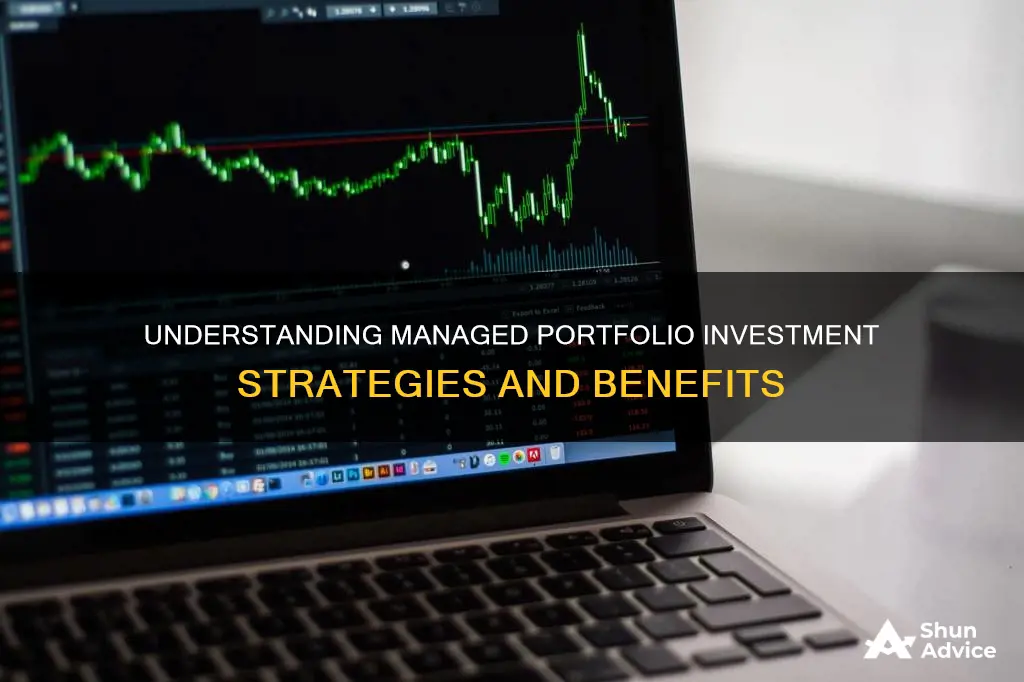
A managed portfolio is an investment account owned by an investor but supervised by an expert portfolio manager. The manager has discretionary authority over the account, allowing them to make investment decisions relating to the owner's goals, needs, risk tolerance, and asset size. Managed portfolios are tailored to the investor's financial needs and risk appetite to help them reach their investment goals within their proposed timeframe. They can be diversified by increasing exposure to global capital markets, either via equity or fixed-income investments, and through alternative investments such as private equity, venture capital, hedge funds, collectibles, real estate, and commodities.
| Characteristics | Values |
|---|---|
| Definition | A managed investment portfolio is an account that is supervised by an expert portfolio manager who administrates and monitors the performance of the client's assets. |
| Who is it for? | Institutional investors or individual investors. |
| Who manages it? | A professional money manager or investment manager. |
| Manager's role | To make investment decisions based on the client's financial needs, risk appetite, goals, and asset size. |
| Investment types | Equities, fixed-income investments, private equity, venture capital, hedge funds, collectibles, real estate, commodities, stocks, bonds, cash, titles to property, and mutual funds. |
| Diversification | Diversification of assets is a key feature, reducing risk and maximising returns. |
| Rebalancing | Regular rebalancing ensures the asset allocation remains aligned with the client's risk profile and investment goals. |
| Costs and fees | Fees are typically calculated as a percentage of the assets under management (AUM). |
| Advantages | Expert management, hassle-free investing, credible asset management, increased control over assets, and cost-effective management fees. |
| Disadvantages | High minimum investment requirements, slow investment and divestment, and high annual fees. |
What You'll Learn
- A managed investment portfolio is an account supervised by an expert portfolio manager who administrates and monitors assets on your behalf
- Managed accounts diversify your portfolio by increasing exposure to global capital markets, either via equity or fixed-income investments
- A managed account is owned by an investor but managed by someone else, such as a professional money manager
- A managed account may contain financial assets, cash, or titles to property
- Managed accounts are personalised investment portfolios customised to the specific risks, goals, and needs of the account holder

A managed investment portfolio is an account supervised by an expert portfolio manager who administrates and monitors assets on your behalf
A managed investment portfolio is a service that allows investors to outsource the management of their investments to an expert.
A managed investment portfolio is an account supervised by a professional portfolio manager who administrates and monitors the performance of a client's assets on their behalf. The portfolio manager has discretionary authority over the account, allowing them to make investment decisions that align with the client's financial needs, risk appetite, goals, and asset size.
Managed investment portfolios offer several advantages over self-managed portfolios. Firstly, they provide access to expert knowledge and investment strategies that may not be available to individual investors. Portfolio managers have a fiduciary duty to act in their clients' best interests, providing peace of mind and potentially reducing the risk of costly mistakes.
Additionally, managed investment portfolios can save time and hassle for clients by handling the day-to-day tasks of investing. This includes tasks such as researching and selecting investments, monitoring the market, and making timely buy and sell decisions.
Managed investment portfolios typically come with fees to cover the cost of professional management. These fees are usually calculated as a percentage of the assets under management (AUM). The specific fee structure can vary depending on the provider and the size of the portfolio, with some providers offering discounted fees for larger portfolios.
It is important to carefully review the fee structure and potential hidden costs before committing to a managed investment portfolio service.
Graph Savings: A Smart Investment Strategy?
You may want to see also

Managed accounts diversify your portfolio by increasing exposure to global capital markets, either via equity or fixed-income investments
A managed investment portfolio is an account supervised by an expert portfolio manager who administers and monitors the performance of your assets on your behalf. Managed accounts diversify your portfolio by increasing your exposure to global capital markets, either via equity or fixed-income investments.
Equity investments refer to stocks or shares in a company, which represent ownership in that company. Fixed-income investments, on the other hand, refer to investments that provide regular interest income, such as bonds. By investing in a range of equity and fixed-income securities across global capital markets, managed accounts can help diversify your portfolio and reduce risk.
For example, if you only invest in stocks from a single country or industry, your portfolio's performance is heavily dependent on the economic conditions and health of that specific market. However, by increasing your exposure to global capital markets through managed accounts, you can invest in a wider range of industries and countries. This diversification means that if one market experiences a downturn, your portfolio's overall performance may still remain stable due to the positive performance of investments in other markets.
Additionally, managed accounts can provide diversification through alternative investments, such as private equity, venture capital, hedge funds, collectibles, real estate, and commodities. These alternative investments offer further opportunities to spread your risk and potentially enhance your portfolio's performance.
The benefits of diversification are well-known in investment circles. The old adage of "not putting all your eggs in one basket" rings true, as diversification can help to balance your risk and reward. By diversifying your portfolio, you can aim to achieve a more consistent overall return and protect yourself from significant losses.
However, it is important to note that diversification does not guarantee against losses, and it may also lead to lower portfolio-wide returns. Diversification is about finding the right balance between risk and return to meet your financial goals and risk tolerance.
Strategies for Investing While Saving for a Home
You may want to see also

A managed account is owned by an investor but managed by someone else, such as a professional money manager
A managed account is a portfolio owned by an investor but supervised by a professional money manager. The investor can be an individual or an institutional investor. The money manager is hired by the investor and has discretionary authority over the account, allowing them to make investment decisions that align with the investor's goals, needs, risk tolerance, and asset size.
The money manager actively oversees the account and its trading activity, investing on the investor's behalf to help them reach their financial objectives. They will typically supply the investor with regular reports on the account's performance and holdings.
Managed accounts can be beneficial for investors who want to outsource their portfolio management, either due to a lack of time, expertise, or interest in managing their own investments. By hiring a professional money manager, investors can gain access to their expertise and insights, potentially improving their investment returns.
However, it's important to note that managed accounts typically come with substantial minimum investment requirements and annual fees, which can impact overall returns. The fees are usually calculated as a set percentage of the assets under management (AUM).
When deciding whether to hire a professional money manager, investors should carefully consider their own financial situation, goals, and preferences. It's essential to understand the costs and potential benefits of managed accounts before making any decisions.
Create a Portfolio on Investing.com: A Step-by-Step Guide
You may want to see also

A managed account may contain financial assets, cash, or titles to property
A managed account is an investment portfolio that a financial expert oversees on behalf of a client. The account owner can be an institutional investor or an individual retail investor. The financial expert, or money manager, has discretionary authority over the account and makes investment decisions based on the client's needs, goals, risk tolerance, and asset size.
- Financial assets: A money manager may invest in stocks, bonds, commodities, or currencies on behalf of the client. They may also invest in crypto, which is a relatively new asset class.
- Cash: A managed account may contain cash, which can be used to purchase financial assets or other investments. The money manager can invest this cash to grow the client's portfolio.
- Titles to property: A managed account may also include titles to property, such as real estate. The money manager can help the client invest in property or manage any income generated from rental properties.
The money manager's goal is typically to grow the investments in the portfolio, which can provide them with higher earnings based on commission or fees and offer the investor profits. They supply the client with regular reports on the account's performance and holdings.
It is important to note that managed accounts often come with substantial minimum investment requirements and transactional fee structures. Many managers require a minimum investment of $250,000, though some may accept lower amounts such as $100,000 or $50,000. The manager's annual fee is usually calculated as a percentage of the assets under management (AUM), with most fees ranging from 1% to 2% of AUM.
Overall, a managed account provides clients with access to a financial expert who can help them make investment decisions, grow their portfolio, and achieve their financial goals.
Hiring an Investment Manager: Key Considerations for Success
You may want to see also

Managed accounts are personalised investment portfolios customised to the specific risks, goals, and needs of the account holder
A managed portfolio is an investment account owned by an investor but supervised by a professional portfolio manager. The manager has discretionary authority over the account, allowing them to make investment decisions that align with the investor's goals, needs, risk tolerance, and asset size.
For example, an investor with a high-risk tolerance may seek exposure to volatile markets, hoping for higher returns. On the other hand, a conservative investor may prefer stable investments like bonds and blue-chip stocks to minimise growth and the risk of losses.
The manager will regularly rebalance the portfolio to ensure it aligns with the investor's risk profile and financial objectives. This involves restoring the initial combination of allocated assets, repositioning investments, and taking advantage of new market opportunities.
Managed accounts offer several benefits, including hassle-free investing, credible asset management, increased control over assets, and cost-effective management fees. However, they also come with substantial minimum investment requirements and high annual fees, which can impact overall returns.
Building a Socially Responsible Investment Portfolio: Doing Well by Doing Good
You may want to see also
Frequently asked questions
A managed portfolio investment is an account owned by an individual or institutional investor but supervised by an expert portfolio manager. The manager has discretionary authority to make investment decisions on the owner's behalf, based on their financial needs, risk appetite, and investment goals.
Managed portfolios are typically diversified across asset classes, sectors, and geographies to reduce risk and maximise returns. Portfolio managers invest in a range of assets, including stocks, bonds, commodities, and alternative investments such as private equity and real estate. They monitor and adjust the portfolio to meet the owner's objectives and financial goals.
Managed portfolios offer hassle-free investing, as the day-to-day management is handled by experts. They provide access to professional investment expertise, helping investors reach their financial goals. Managed portfolios also offer increased control and transparency over assets, allowing investors to switch assets within the portfolio as desired.
Managed portfolios typically have an annual management fee, calculated as a percentage of the assets under management (AUM). The fee varies by manager but often ranges from 1% to 2% of AUM. Some managers may also charge trading fees and supplemental fees for auxiliary services such as tax planning.
When deciding between a managed portfolio and other options like mutual funds, consider your financial goals, risk tolerance, and investment preferences. Managed portfolios offer more customisation and control over assets but often have higher minimum investment requirements and fees. Mutual funds, on the other hand, are more affordable and liquid but offer less transparency and control.







